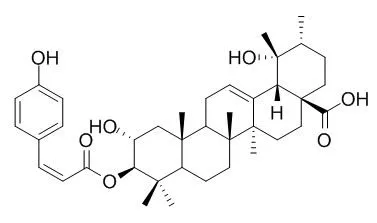| In vitro: |
| J. Ethnopharmacol.,2008 Mar 28;116(3):554- 60. | | Antibacterial compounds from Planchonia careya leaf extracts.[Pubmed: 18289814 ] |
METHODS AND RESULTS:
Six known compounds were isolated from the leaf extracts and were identified as 1, (+)-gallocatechin; 2, gallocatechin-(4alpha-->8)-gallocatechin; 3, 9(S)-hydroxy-10E,12Z-octadecadienoic acid (alpha-dimorphecolic acid); 4, 2alpha,3beta,24-trihydroxyolean-12-en-28-oic acid (hyptatic acid-A); 5, 3beta-O-cis-p-coumaroyltormentic acid(3-O-cis-p-Coumaroyltormentic acid ); and 6, 3beta-O-trans-p-coumaroyltormentic acid.
CONCLUSIONS:
Compounds 5 and 6 were weakly selective for vancomycin-resistant Enterococcus (VRE) compared with eukaryotic cells, with an MIC of 59.4microg/mL and a 50% inhibitory concentration (IC(50)) of 72.0microg/mL for MA104 cells. | | Phytochemistry,2002 Feb;59(3):315-23. | | Production of bioactive triterpenes by Eriobotrya japonica calli.[Pubmed: 11830140] | Callus tissue cultures induced from an axenic leaf of Eriobotrya japonica (Rosaceae) produced triterpenes in large amounts (ca. 50 mg/g dry wt).
METHODS AND RESULTS:
Nine triterpenes were characterized as ursolic acid, oleanolic acid, 2alpha-hydoxyursolic acid, maslinic acid, tormentic acid, 2alpha, 19alpha-dihydroxy-3-oxo-urs-12-en-28-oic acid, hyptadienic acid and a mixture of 3-O-cis-p-Coumaroyltormentic acid and 3-O-trans-p-coumaroyltormentic acid. The triterpene composition in the callus tissues was noticeably different from that in intact leaves. The contents of tormentic acid with antidiabetic action, and 2alpha, 19alpha-dihydroxy-3-oxo-urs-12-en-28-oic acid with anti-HIV activity, were much larger than those in the intact leaves.
CONCLUSIONS:
All of the triterpenes isolated from the callus tissues showed an inhibitory effect comparable to (-)-epigallocatechin gallate (EGCG) of green tea on the activation of Epstein-Barr virus early antigen (EBV-EA) induced by 12-O-tetradecanoylphorbol-13-acetate (TPA).
2alpha, 19alpha-Dihydroxy-3-oxo-urs-12-en-28-oic acid was the most potent inhibitor among them and caused a significant delay of two-stage carcinogenesis on mouse skin. |
|






 Cell. 2018 Jan 11;172(1-2):249-261.e12. doi: 10.1016/j.cell.2017.12.019.IF=36.216(2019)
Cell. 2018 Jan 11;172(1-2):249-261.e12. doi: 10.1016/j.cell.2017.12.019.IF=36.216(2019) Cell Metab. 2020 Mar 3;31(3):534-548.e5. doi: 10.1016/j.cmet.2020.01.002.IF=22.415(2019)
Cell Metab. 2020 Mar 3;31(3):534-548.e5. doi: 10.1016/j.cmet.2020.01.002.IF=22.415(2019) Mol Cell. 2017 Nov 16;68(4):673-685.e6. doi: 10.1016/j.molcel.2017.10.022.IF=14.548(2019)
Mol Cell. 2017 Nov 16;68(4):673-685.e6. doi: 10.1016/j.molcel.2017.10.022.IF=14.548(2019)